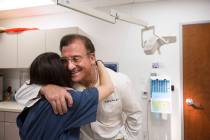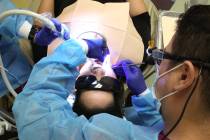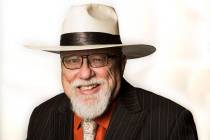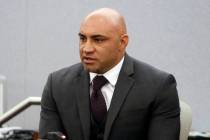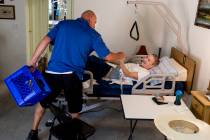Vickers latest celebrity activist
It had been a staple of medical journals and long covered in the health pages of newspapers: If a woman has either a defective BRCA1 or BRCA2 gene, prophylactic surgery can decrease the average 65 percent risk of developing breast cancer to about 5 percent.
But it wasn’t until last year, when Oscar-winning actress Angelina Jolie announced she had a double mastectomy to lessen her risk of developing breast cancer, that most Americans realized the gravity of a BRCA mutation diagnosis.
As I drove to the Las Vegas Motor Speedway last week to interview NASCAR driver Brian Vickers — he has a problem with blood clots and wants to raise awareness about a condition that kills 300,000 Americans a year — I couldn’t stop thinking about the ever-growing power of celebrity in the United States when it comes to examining illness and treatment.
Michael J. Fox, Parkinson’s disease. Halle Berry and Tom Hanks, diabetes. Toni Braxton, lupus. The list goes on.
As Dr. Barron Lerner of Columbia University discusses in his book, “When Illness Goes Public: Celebrity Patients and How We Look at Medicine,” a crucial part of disease activism “is the ability to obtain research funding from the government. So is the ability to raise private money to establish disease-specific foundations. And the best way to obtain both types of funding is to have a celebrity face associated with the disease.”
Although an admirer of disease activism by celebrities, Lerner notes there can be a downside. Although he says a celebrity lobbying Congress can secure greater government appropriations for disease-specific research, it often reduces the amount of research funding for other diseases, particularly those without a celebrity face.
When the R.A.R.E. Project reports 30 million Americans suffer from thousands of rare diseases, most of which receive little research support — 95 percent of the conditions have no therapies and half are without a disease-specific support foundation for funding — the need for what celebrities do best, drawing attention to a problem, becomes even more clear.
When it comes to deep vein thrombosis or DVT, Vickers, 30, is a passionate spokesman. Also called “Economy Class Syndrome,” DVT is a clotting condition attributed to long hours of immobility, like that found in confined airliner seating. People have “to get up and move,” the driver stresses.
Vickers — at age 20 he became the youngest champion in any one of NASCAR’s three top-tier series — could have easily died in 2010 when he was diagnosed with blood clots that began in his leg and moved to his lungs. The problem began in Alabama after two races at the Talladega racetrack followed by a long flight where he never moved from his seat.
“I had shortness of breath and pain I basically ignored,” he said as we sat at the racetrack where he recently finished 13th in the Kobalt 400 race. “I thought I was in great shape and invincible. You’ve got to be seen by a doctor when you hurt.”
When he finally went to the hospital, he was shocked to learn he had blood clots that would make him sit out the rest of the season. He took blood thinners, the usual treatment, to correct the problem. He also underwent surgery for a heart defect.
Like most people, Vickers had never heard of DVT. Even though NBC news correspondent David Bloom died of it in Iraq in 2003 after traveling in cramped conditions in a tank — a blood clot traveled from his leg to his lungs and killed him — stories about his death did little to make people more aware of the condition. A 2002 survey by the American Public Health Association showed only a quarter of American adults knew anything about it.
“It’s a real problem,” said Dr. Eddy Luh, a Las Vegas surgeon. “The country’s slowly getting educated that immobility, trauma to an area, and a genetic predisposition to clotting are three main factors in developing DVT.”
When confined to an affected area, typically the lower leg, the symptoms of DVT are pain, swelling, tenderness and skin discoloration. Unfortunately, half the time DVT has no symptoms at all and the first symptoms evolve from a pulmonary embolism, when a blood clot breaks off and moves into the lungs, where it can be fatal if it completely blocks an artery.
Even doctors don’t always suspect the condition. Vickers said that when he showed up at the emergency room in 2010 with classic signs of a pulmonary embolism — shortness of breath, pain in the chest, rapid pulse and sweating — he was given antibiotics for pneumonia. Only through further testing was it found that blood clots were his problem.
Dr. Jack Ansell, a New York City-based specialist in thrombotic disorders who has met with Vickers, says 900,000 Americans develop clots each year. The third of them who die of DVT annually is more than the yearly combined number of deaths from AIDS, breast cancer and motor vehicle accidents.
“I’m so glad we have Brian Vickers bringing attention to it,” he said.
After wearing a protective boot in 2013 for an injured ankle and calf, Vickers developed another clot — “it was that immobility again” — that kept him out of racing and had him using blood thinners again for three months.
“I realize because of racing I have a platform for talking about DVT that other people don’t have,” he said. “I feel like I’ve been blessed. I have the chance to do good, to encourage research, to help people. Yes, I’ve been blessed.”
(To learn more about DVT, go to www.stoptheclot.org.)
Contact reporter Paul Harasim at pharasim@reviewjournal.com or 702-387-2908.








